Last month I bought “Red Scribble,” a painting by American mathematician, computer scientist and SF writer Rudy Rucker. Why I bought it starts over thirty years ago, when I was in my mid-teens, and my uncle Samuel Ajzenstat (1937–2013) gave me two books.
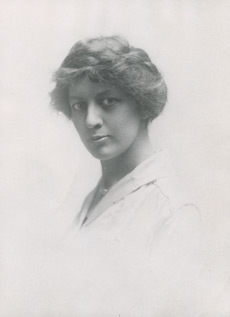
The great Toronto children’s librarian Lillian Smith (who now has a library named after her) said: “The right book, to the right child, at the right time.”
(I generalize that as, “The right book, to the right hands, at the right time.” Of course by “book” I mean book or article or comic book or movie or podcast or whatever. It’s like the second and third laws of library science put together: “Every reader their book” and “Every book its reader.”)
The right book to the right child at the right time can change a life and change the world. Every children’s librarian knows it, and they make it part of their work. Many people who had a good librarian when they were children know it too, because it happened to them. One day, the recommendation, with an unknown book handed over the counter: “I think you might like this.” The sudden understanding of the child that this person, this adult, this librarian, with their glasses and cardigan, who’s been quietly sitting behind that desk, has actually been watching them, observing them, mentally noting the books they’ve been borrowing, and understands their secrets better than their parents or siblings or friends—and would never reveal any of that except by handing over a good book to read. Because that’s what librarians do, and librarians know how to keep secrets.
(Of course, the children have to go to the library for that to happen. So my advice is: gets kids started early on going to the library. Then let them go on their own. While you’re at it, go yourself.)
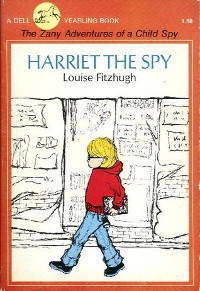
Non-librarians can do this too. It’s one of the pleasures of knowing young people who like books. You wait for the right moment and then hand over Harriet the Spy or The Phantom Tollbooth or whatever seems right. It doesn’t always work—and sometimes the effect is delayed, and you don’t find out about it for years—but when it does, ah, that’s magic. That’s deep book magic.
That’s what Uncle Sam (a philosophy professor) did when I was sixteen, twice at once. I remember where we were, but not what the occasion was. It might have been summer and we were getting together for a birthday or just a family dinner, or it might have been around Christmas. Whatever was going on, he gave me two books: Infinity and the Mind: The Science and Philosophy of the Infinite by Rudy Rucker and Godel’s Proof by Ernest Nagel and James R. Newman. They’re still on my shelves, and as it happens they’re right beside each other in QA 9, at N3 and R79.
The main body of Gödel’s Proof (first published in 1958) is just 100 pages. It sets out what Gödel’s incompleteness theorems were and how they were proved, all in language accessible to the prepared lay reader. It’s not a simple book, but it doesn’t require a specialized mathematical or philosophical background. If someone wants to try to understand what the theorems are about and how the proofs worked, I would still recommend it.
Gödel’s Proof strained my brain, but Infinity and the Mind (1982) blew it. Here’s a part of the review by Philip J. Davis in The American Mathematical Monthly (91.2, Feb 1984) (DOI: 10.2307/2322129) that describes it well:
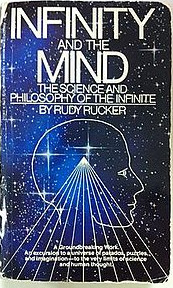
If you are looking for a white water trip down the streams of Infinityland for yourself, your students, or as a graduation present for young relatives, rush out and buy this book written by logician and sci-fi author Rudy Rucker. I guarantee you will get your money’s worth in thrills and spills.
What kind of thing will you see on this guided tour? Well, there are the usual objects: the transfinite ordinals and cardinals; the processes of recursion, self-referral, diagonalization; the paradoxes of Berry, Richards, and the Liar; Hilbert’s Hotel; infinitesimals. All of these are viewed in an up-to-date manner, often from a computer angle. In addition, there are subjects and objects less often seen, or unknown to older trippers: the process of tetration, Conway numbers, and the real fat cardinals such as the inaccessibles, the hyperinaccessibles, the indescribables and the ineffables. One has a view also of universal libraries, fractals, of mind-machine tensions, and of the dialectic split between the “one” and the “many.”
Anyway, the price of admission buys you all this, salted and peppered with comic strips and clips from sci-fi classics, plus a dash of Gödelolotry, plus intimations of the dark, hoaxing occultism of Jorge Luis Borges, plus-for the intrepid-detailed, but hopefully “popular” accounts of big cardinal theory and the incompleteness theorems of logic, plus, lest we forget, a metempsychotic tear shed for the memory of John Lennon. All this and euphoria too.
Oh yeah! Drop that in the hands of a math-loving teenage metalhead living in the 1980s Canadian prairies and you know its found a good home.
Rucker was teaching at Randolph-Macon Women’s College in Lynchburg, Virginia when he wrote the book. Later I learned he was also writing SF and in a punk band. Lynchburg was where Jerry Falwell lived, and it appears in one of Rucker’s novels as Killville.
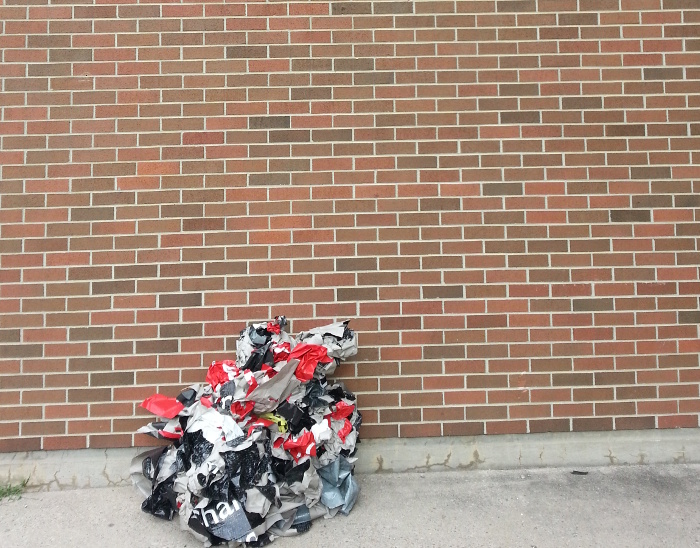
A lot of Rucker’s life appears in his novels, because he’s a transrealist:
The Transrealist writes about immediate perceptions in a fantastic way. Any literature which is not about actual reality is weak and enervated. But the genre of straight realism is all burnt out. Who needs more straight novels? The tools of fantasy and SF offer a means to thicken and intensify realistic fiction. By using fantastic devices it is actually possible to manipulate subtext. The familiar tools of SF — time travel, antigravity, alternate worlds, telepathy, etc. — are in fact symbolic of archetypal modes of perception. Time travel is memory, flight is enlightenment, alternate worlds symbolize the great variety of individual world-views, and telepathy stands for the ability to communicate fully. This is the “Trans” aspect. The “realism” aspect has to do with the fact that a valid work of art should deal with the world the way it actually is. Transrealism tries to treat not only immediate reality, but also the higher reality in which life is embedded.
I didn’t know that then, but I think I figured it out when I read his novels, a good number of which are about a math prof or computer programmer who takes some drugs and leaves this world for a weird other one that probably has sex-crazed space aliens in it.
Before I got into those, though, somewhere back there I read the first two in the Ware Tetralogy, Software (1982) and Wetware (1988): stone cyberpunk. And one day in fourth year (I was studying math) I was looking at magazines in a bookstore and discovered Reality Hackers, which blew my mind again. Rucker was part of that crew and involved with what it turned into: Mondo 2000.
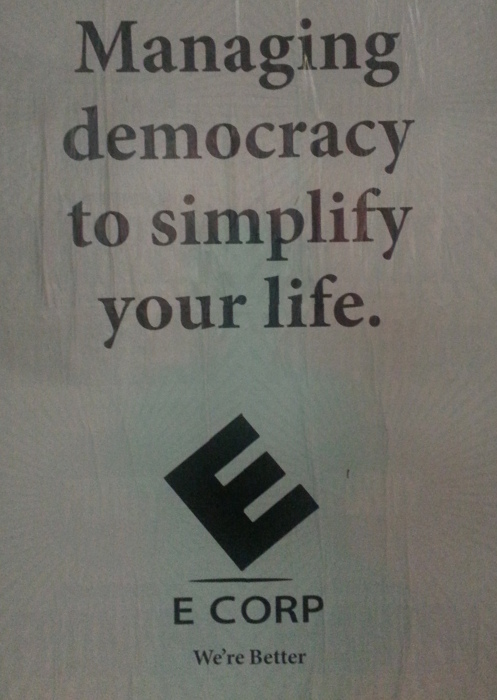
Within a couple of years I was working in that bookstore and I ordered Rucker’s fiction and nonfiction for the shelves. Once I made a cyberpunk display. The store went bankrupt in 1993 in the recession, and after knocking around a while I discovered the internet and started doing web stuff. I kept reading Rucker, and later started following his blog (where I picked up the habit of including unrelated photos) and podcasts. A while back I started following him on Twitter (@rudytheelder). He’s expansive and honest and thoughtful about his life, and worth reading. It’s a rich and interesting life, well lived by someone who appreciates what he’s had.
Some time ago he started painting. I had wanted to get one of his works for a long time, but never saw the one that I knew was right until last month, when on 01 January he posted Bottom of the Year. Midway he said:
I found a drawing on my son’s living-room floor and one of his fourth-grade daughters told me (somewhat loftily) that it was by a first-grade friend of theirs. I liked the composition.
So I copied it, sort of, for a small painting. Very, very hard to draw like a child.
This is his painting, “Red Scribble.” When I saw it, I knew it was the one.
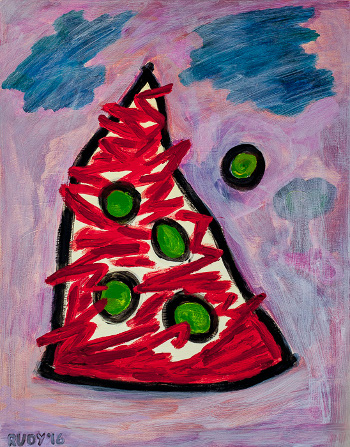
I emailed him, it was available, and a week later it was over the border and in my hands. Now it’s hanging over my desk.
When I look at it I think of Rudy Rucker, of course, and books and mathematics and computer science and hacking, but I also think of my uncle Samuel Ajzenstat, who gave me a book when I was sixteen—the right book, to the right hands, at the right time—and helped set the course of my life. A life that’s also rich and interesting, and I hope—I try—well lived by someone who appreciates what he’s had. As, I am completely certain, was Uncle Sam’s.
PS. Uncle Sam and Aunt Janet gave me a number of other books when I was a teenager, including Thomas Gray, Philosopher Cat by the aforementioned Philip J. Davis, and The Continuing Revolution: A History of Physics from the Greeks to Einstein by Joseph Agassi, both of which are also on my shelves, but those are stories for another day.
 Miskatonic University Press
Miskatonic University Press